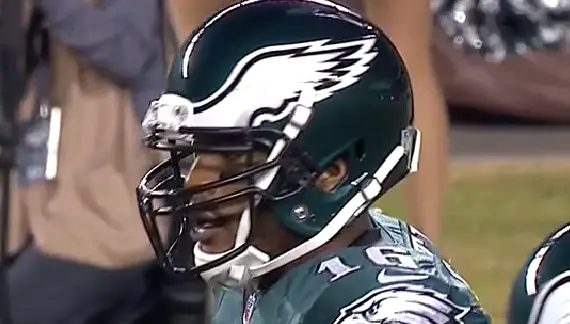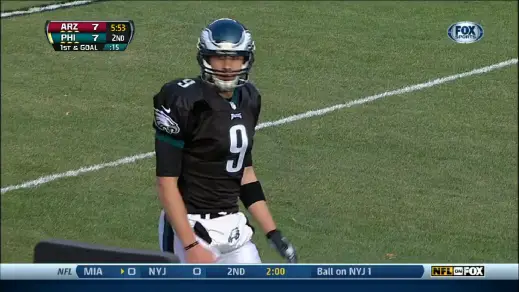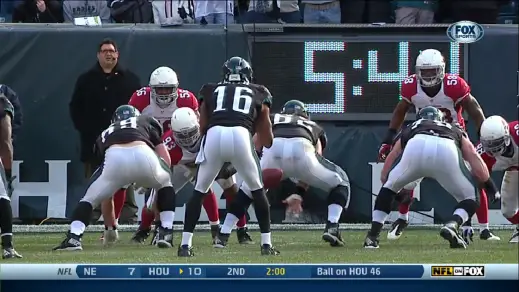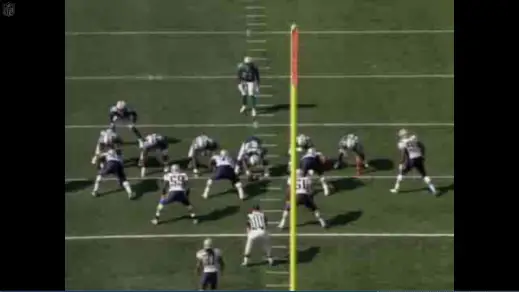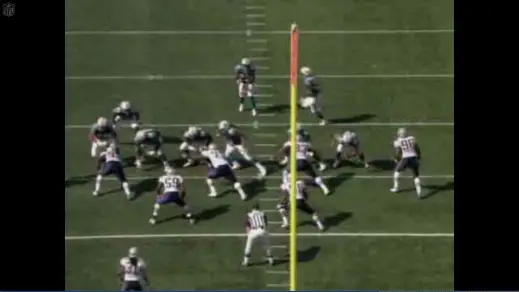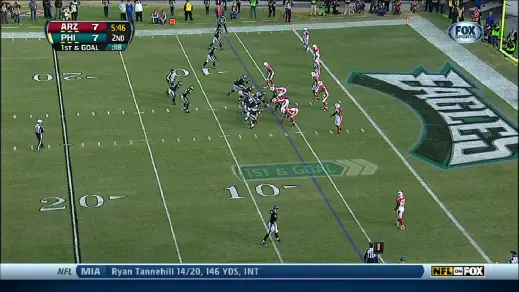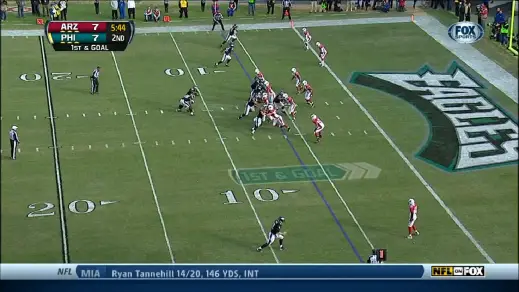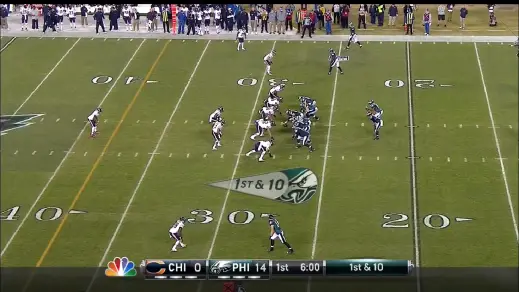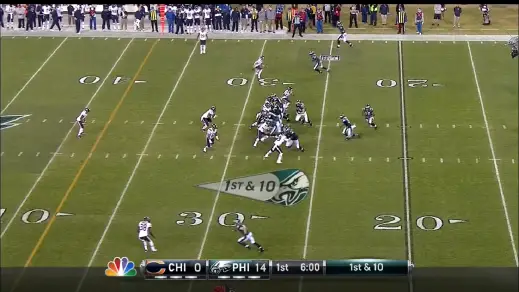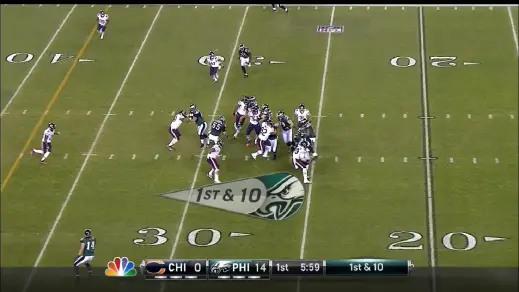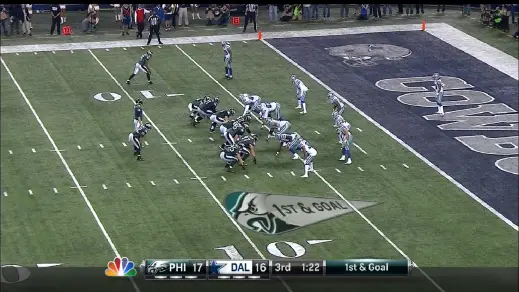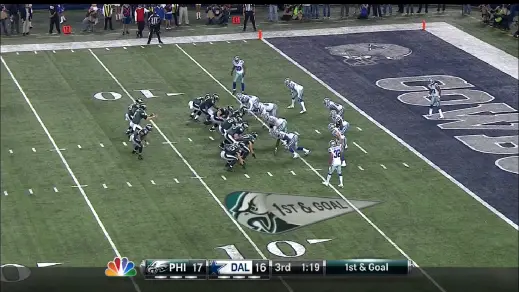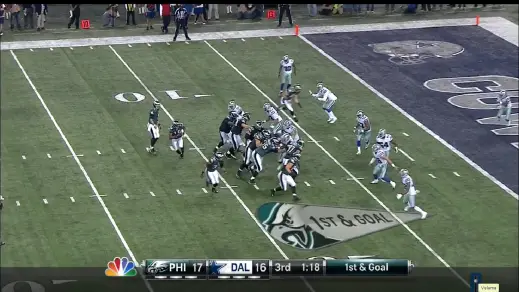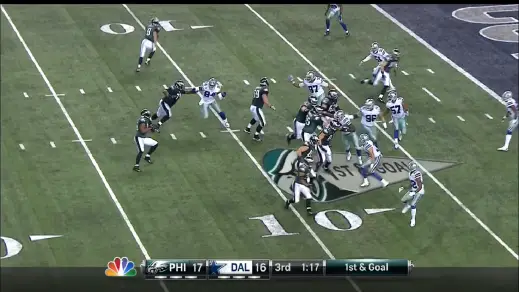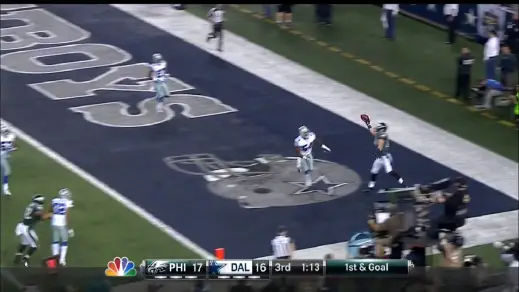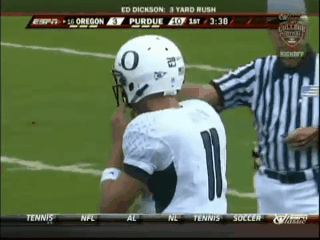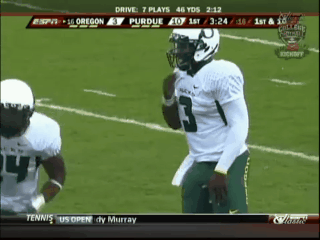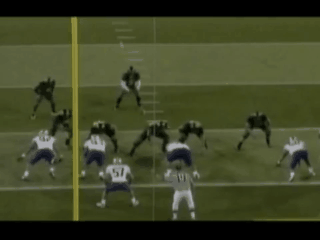It was Dec. 1, 2013. With the score at 7-7 in the second quarter, the Philadelphia Eagles marched to the Arizona Cardinals’ 6-yard line. It was at this moment when Chip Kelly unveiled a surprising wrinkle.
If Nick Foles was there, who was lined up as quarterback?
Meet Brad Smith. He has experience as a wide receiver, running back, quarterback, kick returner and special teams ace.
A few things about this play made people believe this was the Wildcat formation. The starting quarterback was positioned as a receiver, and a player who wasn’t the starting quarterback took the snap. In fact, the Wildcat formation doesn’t require either of those things.
The Wildcat formation always uses an unbalanced line, specifically the tackle-over set. The tight end lines up next to the weakside guard, while the two offensive tackles are next to each other on the playside.
Motion always sets up the play’s run from the Wildcat formation: usually a power run by the player taking the snap, a jet sweep by the motion man or a pass.
Kelly insisted after the Eagles-Cardinals game that he did not call the Wildcat formation.
“It was not a Wildcat play,” head coach Chip Kelly said. “It’s just Brad Smith plays quarterback. So let’s straighten that out right now. We don’t run the Wildcat. It’s just a play. He played quarterback. Nick played receiver because Brad’s really good with the ball in his hands.”
There was no tackle-over set or motion man. Kelly was absolutely correct when he said this play was not the Wildcat. So, if it wasn’t the Wildcat, what was it?
Look at where running back LeSean McCoy lined up. This should be familiar to Oregon and Eagles fans who know how the Inside Zone Read works.
Ignore the fact that Smith fumbled the ball. That isn’t the important part. McCoy was preparing for the mesh point with Smith, as he would during an Inside Zone Read.
The offensive line was zone blocking the defense. It left the outside linebacker unblocked, probably because Smith was supposed to be reading him on this play.
It is also noteworthy that there were three receivers (Riley Cooper, Jason Avant, Foles) who each faced single-coverage.
Cooper ran what appeared to be a corner route. Avant ran a crossing route. Foles took All-Pro Patrick Peterson out of the play by lining up at receiver. It is possible Kelly called a packaged play, an Inside Zone Read packaged with an intermediate pass.
It might be reasonable to blame Kelly for inadequately preparing the Eagles to execute this play, but his play-calling should not be at fault. I’ve concluded that this play was either the Inside Zone Read or a packaged run/pass play. Because these plays are staples of the Eagles’ offense, the notion that this play was a flashy gadget play is nonsense.
Yet, it is reasonable to ask the following: Why even bother making Smith the quarterback for a play when Foles was playing well on this drive? Or for that matter, why not use Michael Vick since he rejoined the active roster as Foles’s backup?
It is likely there are some play-calls that Kelly is more willing to make with Smith at quarterback than with Foles or Vick.
Against the Bears, the Eagles used a tackle-over set with right tackle Lane Johnson positioned between left tackle Jason Peters and left guard Evan Mathis. There was no motion man, so this was still not the Wildcat.
This was a classic power play. The linemen on the play-side were down-blocking. Running back Chris Polk was the lead blocker and did a nice job blocking the defensive tackle. Right guard Todd Herremans pulled to the left and entered the crease to block the playside linebacker.
Smith entered the hole for a two-yard gain. His versatility allowed Kelly to simultaneously avoid risking the health of his top two quarterbacks and keep an inside QB power run on the table.
Defenses must always be aware of the possibility that Smith will pass the ball. In fact, this could happen in a formation where he isn’t even lined up at quarterback.
Smith came into this game as a receiver. Nothing too unusual so far.
He motioned over and prepared for the surprise.
Smith ran to the right, as if this was a sweep.
Smith looked at Foles, who wasn’t even looking for the ball. He was likely just a decoy on this play.
Foles attracted double coverage, as the safety read Smith’s eyes and assisted the cornerback covering Foles. This allowed Zach Ertz to get open in one-on-one coverage against a linebacker. Unfortunately, Smith’s pass was behind him and he couldn’t make the catch.
There was one Oregon player who resembled Smith as an offensive weapon: Chris Harper. While Kelly was the offensive coordinator in 2008, Harper played quarterback, running back and receiver. He transferred the next year to Kansas State.
Kelly and head coach Mike Bellotti experimented with putting Harper at quarterback in the middle of games. Against Purdue, they instructed pocket-passer Justin Roper to get off the field.
Harper was a running threat and raw passer. Bellotti and Kelly didn’t mind tipping their hand close to the red zone. This QB sweep was effective because of Harper’s speed down the sideline. Roper returned to the game after this play.
Additionally, Harper sporadically played quarterback on zone read plays. It is noteworthy that Harper earned meaningful playing time when Oregon lacked a true “dual threat” quarterback.
Foles’s performance last season proved Kelly did not need a mobile quarterback to make his offense flourish, but it is possible he viewed Smith as a means of compensating for Foles’s lack of mobility. Smith is a situational player who makes the read option more potent and makes Kelly more comfortable calling inside QB runs. If Smith makes the roster this season, expect to see more of the formation with him at quarterback. Just don’t call it the Wildcat.
Top photo from video
Joe Kearns is a senior at the Pennsylvania State University majoring in Economics. He intends to pursue a career in the banking and financial services industries, but is also a lifelong diehard Philadelphia Eagles fan who enjoys analyzing college and pro football film as a hobby. Along with being a fan, Joe’s football knowledge comes from his days as a center, defensive tackle, and long snapper for his high school in Mt. Lebanon, Pa. Though he is a Nittany Lion, he has taken a great interest in the Oregon football team since Chip Kelly became the Eagles head coach. He loves pancakes ( and not just the breakfast food).

